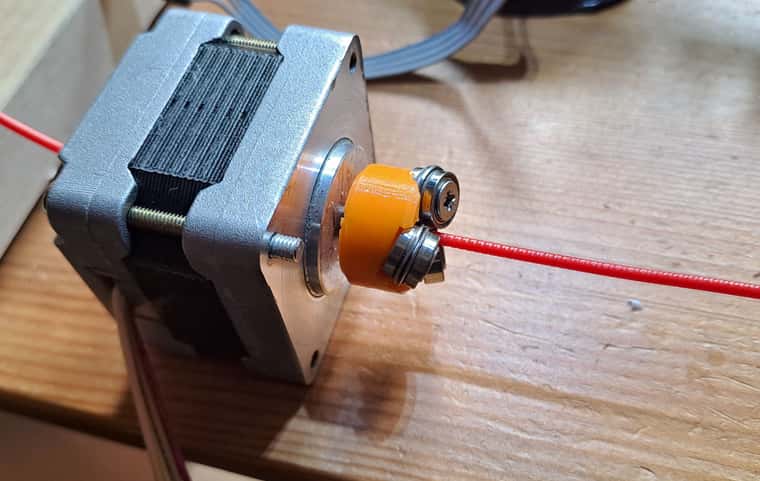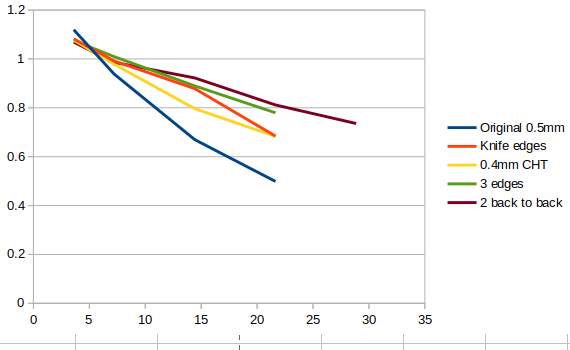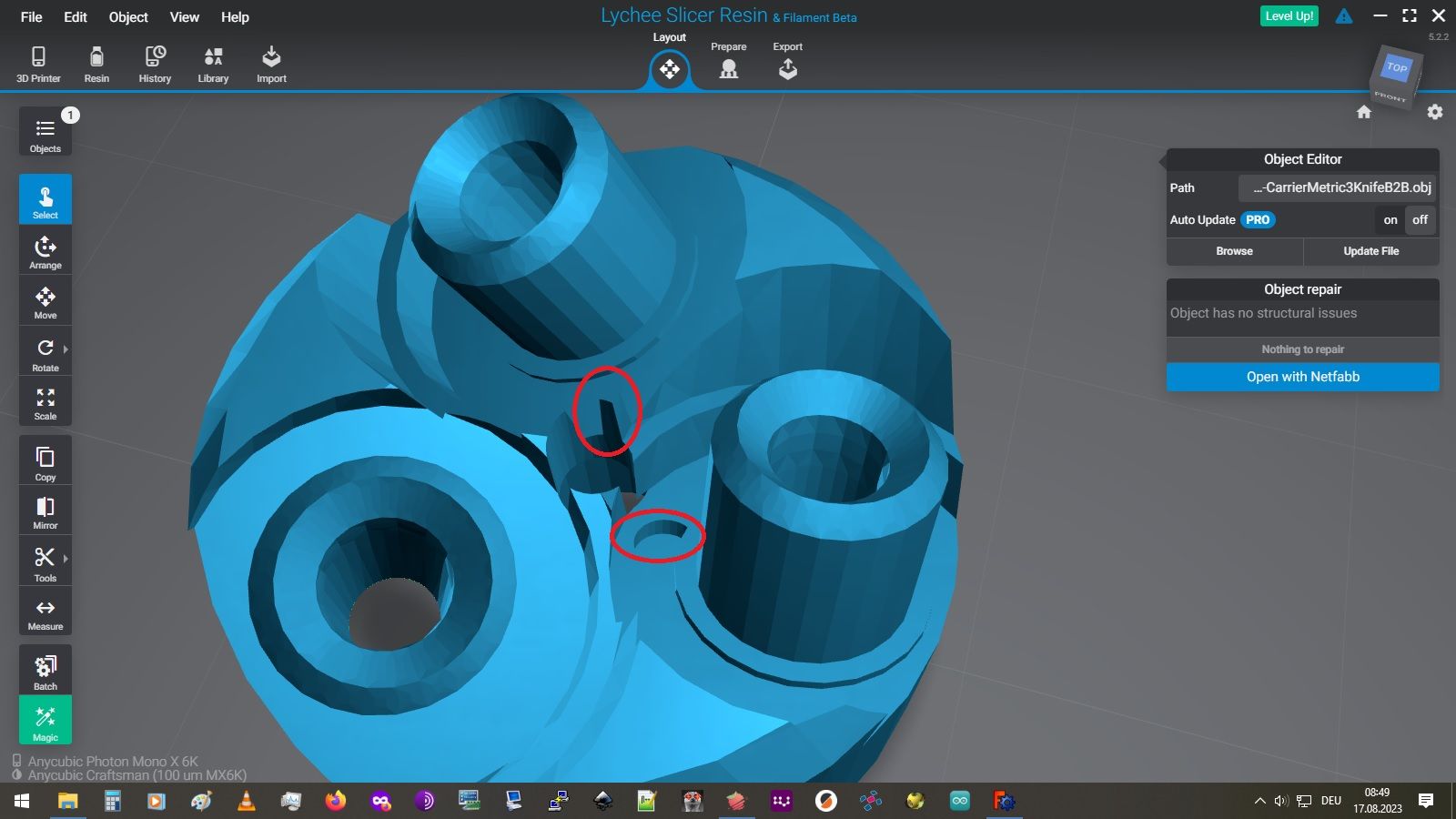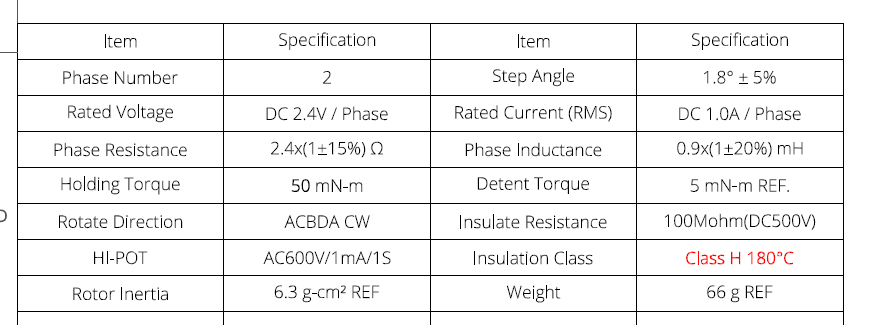Hollow shaft extruder
-
Success! I've finally completed a 16 minute benchy with my VDE extruder. Somewhat under-extruded in places, but pretty good considering. The rest of the machine hardware is also pretty low spec. 12V bedslinger running on an 8 bit AVR mainboard. Posted a video on youtube.
That's been a long-running project. Glad to put it to bed.
Next up: a new VDE idea to try with 3 pairs of flanged bearings. (And @o_lampe then I'll send three of the bearings to you. It was while I was grinding them that it occurred to me that three extra bearings might be an interesting thing to test!)
-
My latest VDE design is even better than the one I used for the 16 minute benchy. It features two pairs of flanged bearings mounted back to back plus a plain bearing.

I'd like to experiment with three pairs of flanged bearings but need to buy more bearings before I can do that.
Here are some graphs to give an idea of how different designs are affected by compression of the helical thread:
Y is thread pitch / theoretical thread pitch and X is actual linear extrusion speed in mm/s (i.e. taking compression into account).
- The baseline is what I was using when this thread started. It has two chisel edged bearings and a plain bearing and is extruding through a traditional 0.5mm nozzle.
- The red line has larger bearings with knife edges (i.e. a / shape rather than a |/ shape). Both of these reduce compression effects. These are lower quality bearings and I believe this accounts for the red line performing worse at low speeds.
- The yellow line replaces the nozzle with a 0.4mm CHT clone from aliexpress which I have modified to enlarge the three holes so that there is a sharp edge in the middle rather than a flat face. These clone CHT nozzles actually increase back pressure at low flow rates but they do not have the sudden drop off at around 6mm/s.
- The green line is the extruder I used for my 16 minute benchy. It replaces the plain bearing with a knife edge bearing so it has three knife edges rather than 2.
- The last line is my latest experiment with 2 pairs of back to back knife edged bearings. This is slightly better and is the only extruder where I have been able to extrude at an instructed 12mm/s (and getting 8.54mm/s) without the compression causing the knife edges to start falling into the wrong helical thread path, causing inconsistent extrusion.
-
The type of bearings used will wobble a bit on the axles because they have a single set of balls in the race. HDD head armature bearings seem to be built so they can't wobble- either they use needle bearings or they have more than one race and set of balls. They are small, flanged, and often have a threaded stud. They are free if you have a few old HDDs available. They might be ideal for this application:

-
@mrehorstdmd I like the thinking behind it, but these bearings are made for silent and smooth run with a balanced load.
I wonder how long they last when you put them under stress with axial and radial load? And how would we get enough of them to satisfy the expected huge demand?
@tombrazier
Maybe it's better to pressfit a collar on a normal bearing? It could sit in the center above the balls and we could grind the edge before it is pressed on.
The fit wouldn't need to be tight. A bit of Loctite would fill the smallest gaps and keep the collar in place.The collar could be lasercut from a springsteel sheet with a starfish-like cutout in the center. Then we bend the cutout 90° with a tool in a benchpress.
//edit
even better: press 3 of the starfish legs in one direction and the other three in the opposite direction. -
@mrehorstdmd The edge needs to have a diameter of < 10mm. If you can source multiple hard drive bearings this small, it would be an idea to try. But it would be something most people can't do.
I am using ABEC-3 rated bearings which have very little play. Rq3 who got me into this uses ABEC-5. However with my back to back arrangement, I now do have two ball races for each bearing pair and the knife edges are at the centre of the bearing pair so the off-centre torques are cancelled out.
@o_lampe I lack the equipment to do the cutting and bending you suggest. But for someone who has it, that makes sense to me. And this seems like a better mass production approach than grinding flanged bearings.
-
@tombrazier Your double bearing solution is interesting. The two bearings should support each other. Did you have to change the angle? Looks like you might have ground the flanges different.
-
@breed No, the angle is the same. The bearings are now ground on both edges, rather than just one as I demonstrated in a past youtube video on the VDE-100. Since that time I have acquired a Dremel style tool that allows me to grind both edges.
-
Hmm, this comment on Marlin feature request #9852 makes me think that my latest version of the VDE-100 extruder is now on a par with other extruders for underextrusion at high flow rates. I had been reading people's graphs as extrusion plotted against actual flow rate. But Mihai's graph for his Ender 3 is plotted against commanded speed. And an added complication is that I was measuring in mm/s rather than cubic flow rate in mm^3/s.
When I rearrange my data my best extruder compares quite well with Mihai's data for his Ender 3 for a 0.4mm nozzle. And this is with a CHT clone nozzle (also 0.4mm) which has higher resistance at low flow rates:

Note the lines on my graph represent progressive changes. So all the changes from the earlier lines are included in each line.
-
@tombrazier said in Hollow shaft extruder:
I was measuring in mm/s rather than cubic flow rate in mm^3/s.
If both measurements were done with the same nozzle diameter, they are scalable.
It get's tricky when mm/s was the toolhead speed. Then you'd need to know extrusion width and layer height.
With the extrusion rate I can achieve with the BLDC-sherpa, I'm confident of using a volcano hotend with bigger nozzles.
That wasn't possible before, unless I printed much slower. -
@tombrazier I guess your Dremel will be pretty busy for a while. Here's the first print of the double roller VDE-100

Some artifacts I've noticed when I converted to .obj. They actually show in the print..

-
@o_lampe said in Hollow shaft extruder:
It get's tricky when mm/s was the toolhead speed.
Sorry I might not have been clear. It was filament speed. Multiple by 1.75^2 * pi / 4 to get volumetric speed.
-
@o_lampe said in Hollow shaft extruder:
Here's the first print of the double roller VDE-100
Fab, thanks.
Some artifacts I've noticed when I converted to .obj. They actually show in the print..
The hole is intended. It marks bearing number 1. In this case that's not really relevant. But when there were different kinds of bearings or (because I ran out of bearings to grind!) different diameter bearings in different positions, I needed the marker.
The bits in the middle are fine. If they printed really well and are strong enough, they can act as an extra guide for the filament. Otherwise they can be broken or cut off easily enough.
-
@tombrazier How do you mount it on the stepper? There is no radial hole for a grub screw.
-
@o_lampe I press it onto the shaft. It holds with friction. The torque is so low that a grub screw is not necessary.
-
 undefined o_lampe referenced this topic
undefined o_lampe referenced this topic
-
@tombrazier is there a link to the double roller version? I want to look at it in cad.
-
due to the continued interest in hollow shaft extruders, @tombrazier and I had a chat with Jason from LDO about a ready made hollow shaft extruder for VDE. We are currently gauging interest in production of some samples.
These are the planned motor specs. The weight is with a 1m wire, actual motor weight is closer to 50g as far as I understand

If anyone is interested in getting one or two, please get in touch with me so we can organize a group order.
-
@breed VDE-Tom-9.1mm_backtoback.step
And the FreeCAD parametric model (well, several models including the back to back one): VDE-Tom.FCStd
-
This post is deleted! -
-
@oliof I figured out, that my NEMA14 steppers have a thicker middle part on the shaft. So it isn't possible to replace the shaft with a 5x1mm stainless tube.
OTOH I'm so happy with my BLDC extruder, that I won't spend money on a LDO stepper.I'm happy to supply resin printed carriers, unless @tombrazier has also found a better source in UK?
The bearings didn't arrive yet, so I can't tell if the carrier needs subtile changes.